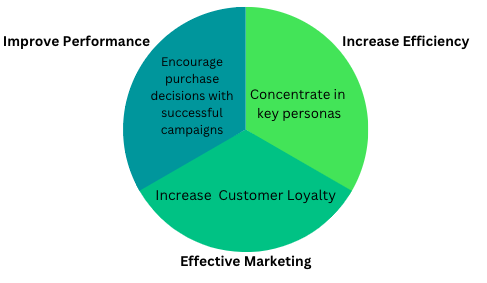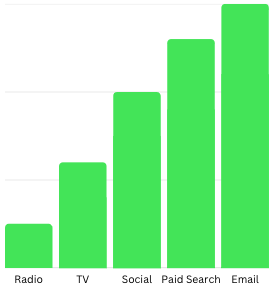Data-Driven Marketing
Definition
Data-driven marketing is when a marketing team builds their strategies after analysing the data collected through customer interaction.
Description

Data helps to gain a better understanding of the target customers. Getting clarity about the customers enables the brands to serve them better. A data-driven marketing facilitates personalised content in which the users will have an increased engagement.
Only 57% of leading organisations state that they tap their rich data to drive innovation, but 27% believe that with data they have been able to create data-driven organisations.
This data is collected through customer’s interactions with third party sites to make marketing effective and efficient. The data is based on evaluations like what excites the customers, their buying behaviour, their preferences, etc.
Organisations can enhance and personalise the customer experience after studying and evaluating the data about their target audience. Data can help organisations make informed decisions to sell better to their customers.
Such insights help brands develop personalised marketing strategies for the maximum possible return on investment. Companies can monitor their performance on regular basis and make changes if they find the need.
Example
Myntra runs one of the largest online fashion platforms. It observes behaviour of all its customers. The brand observed that Anisha visited the page which displayed a long overcoat with hooded furs.
Anisha visited the page almost every second day since it was up for selling, but she did not make the purchase. Now because the brand is largely based on data-driven marketing, it alerted Anisha when the item was offered on sale.
Importance of Data-Driven Marketing Strategy
Data driven marketing strategy helps you to:
- Reach the right people at the right time as you know their interests and behaviour.
- Make necessary changes in the marketing strategies considering the need of the time.
- Hit the target based on the segments you create.
- Utilise multi-channels ads to spread the message right.
- Innovate new products to offer to the customers.
Ways to develop Data-Driven Marketing Strategy
This is how you can develop a data-driven marketing strategy:
Step 1: Gather the data about the customers:
Your existing clients give you the highest opportunity to explore how to offer the customers. It gives you an idea on how you can serve the future customers also. Get maximum data about customer’s demographics, age, location, behaviour, and buying habits.
Use some business intelligence softwares to centralise the data and tap it to maximise the sales.
Step 2: Analyse the data for different trends:
After the data is collected, the next you can do is analyse the data for different patterns and trends. There could be cases like one product is more popular than the other in one region and vice versa.
You can improve your marketing campaigns and serve your customers better. The software is AI enabled that analyses the large part of the data for you effortlessly.
Step 3: Categorise target audience into groups:
Once the data is evaluated completely, you can categorise your audience into different groups. Groups can be based on behaviours, gender, location, etc.
You can use Web Analytics Tools for predictive analytics. Based on this study, you can take actions which will help you motivate customers to complete the actions you want them to take.
Step 4: Create marketing campaigns for different target groups:
Remember the brand Colgate-it has the highest penetration in the market. It was a brand that a common man needed, but the same rule does not apply to all.
Targeting audiences can align your marketing goals with business goals. It further enhances the return on investment you want.
Step 5: Stay connected with the audiences
Connectivity is the biggest issue that one must keep in mind when it comes to generating loyal customers. Email marketing has been observed as the most effective marketing strategy.

Best Practices of Data-Driven Marketing Strategy
These are the best practices of data-driven marketing strategy:
- Provide value to the customers: Data-driven marketing strategy is about providing a clear idea of what is in it for the customers. It makes the marketing campaign a hit.
- Create personalised product recommendations: Data can help to make personalised recommendations after building a user’s profile. The recommendations must highlight what the customers will gain from the products.
- Be transparent: Marketers need to be transparent when they are collecting the data. It is important to mention how the information will be used, stored and secured for future purposes.
FAQs
What trends drive data-driven marketing?
Data-driven marketing is gaining momentum because of the increase in the complexity of the consumer journey. It happens due to the rise in the number of touchpoints. Companies have wider availability of data about these journeys. Also, with dedicated tools brands can easily manage the data.
How are companies using data to drive higher revenue and results?
Data can be used to:
- Identify high-value customers.
- Acquire and retain these customers.
- Attribute value to marketing for quick promotion.
- Build customer segmentation for convenient marketing.
What are the Challenges of data-driven marketing strategies?
These are the challenges of data-driven marketing strategy:
Challenge 1:
- Problem: Gathering the data
- Solution: Collect data from social media and other channels.
Challenge 2:
- Problem: Pulling the data together.
- Solution: Use marketing analytics and other tools to connect all data at one place.
Challenge 3:
- Problem: Data analysis
- Solution: Understand the audience and set up the common data standards.





We would love to have your opinion.